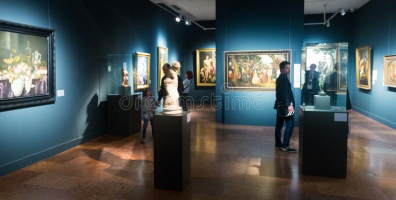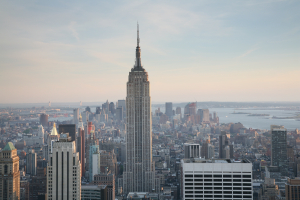Top 12 Notable Buildings in Hungary
Hungary is one of Europe's oldest countries, with a proud culture and a plethora of intriguing activities and landmarks. A large proportion of Hungary's most ... read more...iconic sites are baroque-style monuments emblematic of the imperial and affluent Hapsburg era. Many of them are in Budapest, Hungary's capital and largest city. Naturally, many visitors concentrate on Budapest, a fascinating city with historic sites and a plethora of exciting activities. In this post, let's discover the most amazing buildings in Hungary.
-
The Dohány Street Synagogue, also known as the Great Synagogue or Tabakgasse Synagogue, is a historical edifice located in Erzsébetváros, Budapest's 7th district. It is Europe's biggest synagogue, seating 3,000 people, and a Neolog Judaism center. The synagogue was erected in the Moorish Revival style between 1854 and 1859, with the décor based mostly on Islamic models from North Africa and medieval Spain (the Alhambra). The synagogue's Viennese architect, Ludwig Förster, considered that no particularly Jewish building could be recognized, and hence chose "architectural forms that have been adopted by eastern ethnic groups that are linked to the Israelite people, and in especially the Arabs".
This Budapest structure is roughly 173 by 87 feet in size and was planned as a true basilica with two balconies. The western front contains arched windows with carved stone and brickwork embellishments in the city's heraldic colors of blue, yellow, and red. Above the entrance, a stained-glass rose window rises, and the entryway is flanked on both sides by two copper-domed towers with large arched windows. The Holy Ark is located on the east wall, facing the bimah. The choir appears above the Holy Ark, and the women's galleries are on the top floors. The 5,000-tube organ, which was built the same year as the synagogue, has been played by musicians such as Franz Liszt and Camille Saint-Saens.
Location: Budapest, Hungary
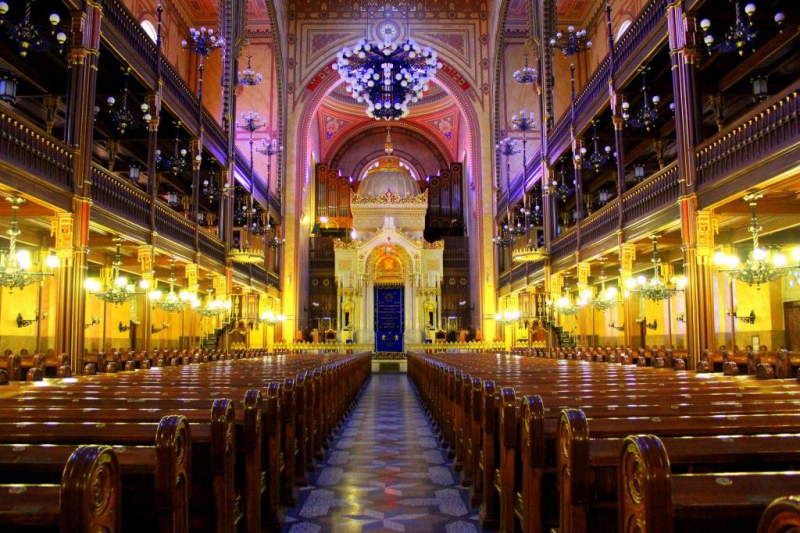
Pinterest 
aceadventurer.com -
The Great Market Hall, also known as the Central Market Hall or Market Hall, is Budapest, Hungary's biggest and oldest indoor market. The proposal for such a big market hall came from Budapest's first mayor, Károly Kamermayer, and it was his largest investment. He retired in 1896 and attended the February 15, 1897, opening ceremony. It is located in Fvám plaza on the Pest side of the Liberty bridge, near the end of the popular pedestrian shopping strip Váci utca.
The Great Market Hall features a symmetrical front with patterned brickwork surrounding four smaller windows and a big main window. A tiny tower stands at extremity of the facade. The entrance is stone and Neo-Gothic, but it is the interior that takes your breath away—climb three levels up and look down on a lively, colorful scene of over 180 booths offering flowers, fresh vegetables, cheeses, meats, and seafood. Most notable are kiosks selling red Hungarian paprika and peppers, which are said to promote fertility and good health, and tanks of live carp at Christmas. The barrel-vaulted roof is six stories high, constructed in a lattice of iron. The overall impression is of an iron and glass cathedral devoted to fresh produce and good food.
Location: Budapest 2, Csarnok ter 1093
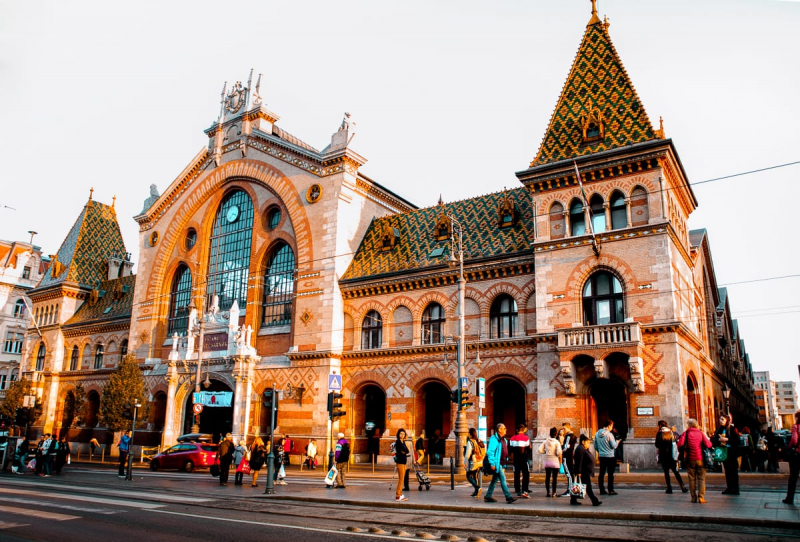
hellojetlag.com 
hellojetlag.com -
At the foot of Gellérthegy Hill in Buda, the Gellért Hotel and Baths face Szabad ság hd (Liberty Bridge). The hill has long been recognized for its thermal springs, which are employed in the Ottoman Turkish tradition of spa baths. Budapest is known for its spas, and the Gellért Hotel and Baths is by far the most opulent. Thirteen springs supply thermal pools within beautifully adorned spa baths designed by dön Lechner, who inspired a generation of Hungarian architects.
Lechner employed contemporary materials and technology while incorporating traditional Hungarian elements. His unique use of ceramics and color in architecture. An architectural historian, Edwin Heathcote, regards Lechner as "an eccentric genius and precursor of modernism". Three of his students, Artr Sebestyén, rmin Hegedus, and Izidor Sterk, enthusiastically expressed his ideas in the Gellért Hotel, which opened in 1918. The interior has glazed, marbled tiles and beautiful mosaics that sparkle in the humid, steamy environment.
Tiled galleries encircle the main indoor pool. A semicircular thermal bath is located at one end, and in good weather, a glass canopy glides up. The luxurious magnificence, exotic design, and dark recesses combine to create a magnificent feast of bath architecture. Baroque cupolas adorn the main entrance, corners, and the entrance to the baths. Outside, there are sun terraces and an open-air pool built into the mountainside. The whole Gellért complex conjures up images of magnificent elegance and sensuous opulence.
Location: Budapest Kelenhegyi út 4 1114, Hungary

G Adventures 
Flickr -
Budapest Ferenc Liszt International Airport, originally Budapest Ferihegy International Airport and still usually referred to as simply Ferihegy, is the international airport serving Budapest, Hungary's capital city. It is by far the largest of Hungary's four commercial airports, surpassing Debrecen and Hévz-Balaton. When it was finished in 1937, the airfield was regarded one of the most modern in Europe, serving as a model for airports such as Dublin and Liverpool. The proposal, with its divided traffic system and modern departure building, had an impact at a time when engineers and architects were developing an altogether new architectural form—the airport for civilian traffic.
The new structures were designed to manage demanding passengers in a fashionable manner, as well as process cargo, enforce customs and immigration procedures, and service aircraft. The design is mostly symmetrical, with two wings connecting to the core cylindrical portion. The sleek, curved design is reminiscent of an airplane. On the upper floor of the center drum, there is a gallery and a top-lit passengers' lobby. The columns were originally glass-faced. An aerial photomontage wrapped around the circular lobby space, which also included a bar and sofas. Interior fixtures like doorknobs were developed in a sleek, Modernist style.
A control tower protrudes from the middle section's top like a ship's bridge, recalling the luxurious world of ocean liners. The nautical theme is enhanced by open viewing balconies and rooftop decks on the side wings. Fighting between the Germans and the Soviet Red Army was ferocious and devastating near Budapest during World Conflict II, therefore it is astonishing that the airfield survived the war mostly intact. The airport remained Budapest's primary air-traffic center until 1950, when Ferihegy Airport (later called) opened.
Location: South-east of center of Budapest

SkyscraperCity 
startlap.hu -
The Hungarian Parliament is one of Hungary's most recognized landmarks, as well as one of the most photographed and visually striking. It was constructed by Hungarian architect Imre Steindl in neo-Gothic style and inaugurated in 1902 on the Pest side of the city, on the eastern bank of the Danube. Since its erection, the Parliament has been Hungary's largest building and remains one of the world's largest legislative structures. It measures 268 meters long, 123 meters broad, and 96 meters tall, making it one of the tallest structures in Budapest. It includes a central dome and a symmetrical main façade facing the Danube.
Aside from its vastness, it is also rich in embellishments, such as the coat of arms above the windows and dozens of sculptures of notable Hungarians. The inside is as impressive, with 10 courtyards, 27 gates, 29 stairs, and around 700 rooms. The most well-known feature is the hendecagonal great hall, which is flanked by the enormous chambers of the Lower and Upper Houses. The last feature of the parliament is the presentation of Hungary's sacred crown in the middle hall. Guided tours of the Parliament are available to learn more about these and other attractions.
Location: Budapest Akadémia Utca 14

Pinterest 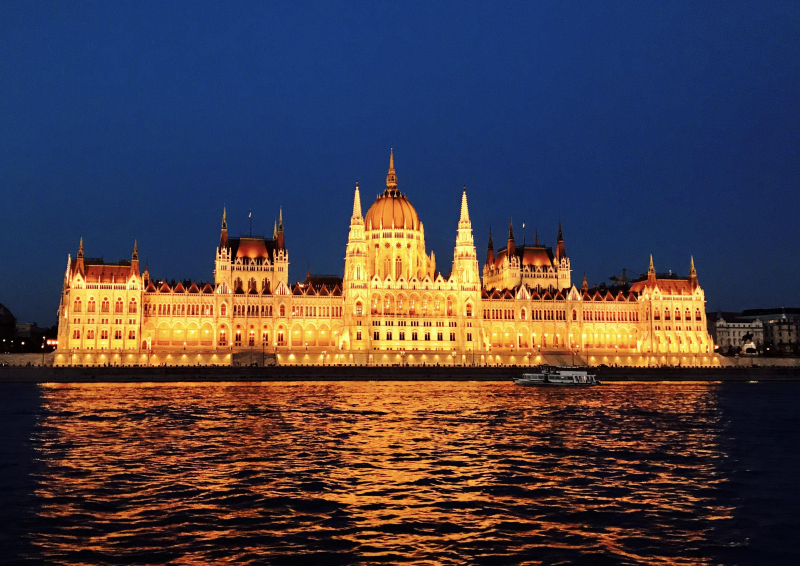
Reddit -
Buda Castle is Budapest's ancient castle and palace complex of the Hungarian Kings. It was completed in 1265, but the vast Baroque mansion that now occupies most of the site was erected between 1749 and 1769. Previously, the complex was known as either the Royal Palace or the Royal Castle. The Hungarian National Gallery and the Hungarian National Museum are currently housed in the castle.
Buda Castle is located on Castle Hill's southern point, surrounded by the touristy district known as Várnegyed (Castle Quarter), which is notable for its Medieval, Baroque, and Neoclassical residences, churches, public buildings, and monuments. The Castle Hill Funicular connects the hill to Clark dám Square and the Széchenyi Chain Bridge. The castle is part of the Budapest World Heritage Site, which was established in 1987. During the Kádár period, the old Royal Palace was destroyed during WWII and reconstructed in a reduced Stalinist Baroque design.
Since 1987, this ancient Hungarian monument has been a component of the Budapest World Heritage site, and it has one of Budapest's most spectacular vistas. Because of its location and size, it can be seen from practically anywhere on Pest's side. Don't miss the magnificent Mace tower, erected in the 13th century and site of some significant battles throughout the years.
Location: Budapest, Hungary
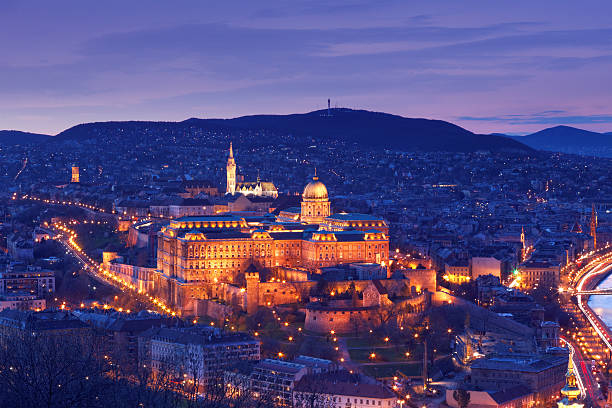
istockphoto 
istockphoto -
The Halászbástya, or Fisherman's Bastion, is a well-known landmark in Budapest, located near the Buda Castle in the city's first district. Due to the spectacular perspective of Budapest from the Neo-Romanesque observation terraces, it is one of the most prominent tourist attractions. The main façade of the Fishermen's Bastion is roughly 140 meters long, with the southern aisle being approximately 40 meters long, the northern aisle being 65 meters long, and the ornate center parapet being 35 meters long. Its seven high-pitched stone towers represent the seven Hungarian chieftains that created Hungary in 895.
The original walls were erected in the 1700s as part of the castle defenses. According to historians, this section of the castle walls was once guarded by the guild of fishermen (halász), who resided under the walls in the so-called Fishtown or Watertown. The current edifice was erected in Neo-Romanesque style between 1895 and 1902 on the foundation of a stretch of the Buda Castle walls by architect Frigyes Schulek, who was also in charge of the restoration of the Matthias Church. As part of the Várkerület District, it has been a World Heritage Site since 1987.
The lower terraces of Fisherman's Bastion are free to see and accessible 24 hours a day, but the top terrace and tower need a ticket. It may be a purely cosmetic monument with pale walls, many windows, arches, arcades, and seats, yet it is unquestionably one of Europe's most compelling and charming sights.
Location: Budapest Tóth Árpád sétány & Gránit lépcső

istockphoto 
istockphoto -
Hsök tere, or Heroes' Square, is a major square in Budapest, Hungary. It is known for its iconic Millennium Monument, which features statues of the Seven Chieftains of the Magyars and other important Hungarian national leaders, as well as the Memorial Stone of Heroes, which is sometimes referred to incorrectly as the Tomb of the Unknown Soldier. It has sculptures of the Seven Magyar Chieftains, or the chiefs of the seven Hungarian tribes that arrived in modern-day Hungary at the end of the 9th century. The square was built to mark the thousandth anniversary of the Magyars' arrival in 1896, with sculptures and enhancements added over the next 50 years.
There are other statues of other Hungarian leaders, as well as the Memorial Stone and Millennium Monument. Sculptor Zala György sculpted several of the sculptures. Heroes' Square is now a UNESCO World Heritage site and a must-see for everyone interested in Hungarian history, from the Magyars to the years of Communist control. Heroes' Square is a short walk from the popular Széchenyi hot spa complex, as well as the Museum of Fine Arts, which is located in the square and conveniently close to the major artery of Andrássy Avenue.
Location: Budapest Andrassy Avenue, Next to City Park in the VI. District 1062

istockphoto 
istockphoto -
The Church of the Assumption of the Buda Castle, also known as the Matthias Church or the Coronation Church of Buda, is a Roman Catholic church in Budapest, Hungary, located on Holy Trinity Square, in front of the Fisherman's Bastion, in the center of Buda's Castle District. According to church tradition, it was erected around 1015 in Romanesque style, albeit few references survive. The existing structure was built in the second half of the 14th century in the florid late Gothic style and was significantly rebuilt in the late 19th century. It was medieval Buda's second biggest church and the seventh largest church in the medieval Hungarian Kingdom.
It is a historic structure with a significant history. Within its walls, two Kings of Hungary were crowned: Franz Joseph I of Hungary and Elisabeth, and Charles IV of Hungary and Zita of Bourbon-Parma. Buda's "Marian Miracle" took place in this chapel as well. During the Holy League's siege of Buda in 1686, a wall of the church - used as a mosque by the city's Ottoman invaders - fell owing to cannon fire. An antique votive Madonna figure was discovered hiding behind the wall. The morale of the Muslim garrison disintegrated as the sculpture of the Virgin Mary appeared before the praying Muslims, and the city fell on the same day.
Location: Budapest, Hungary

istockphoto 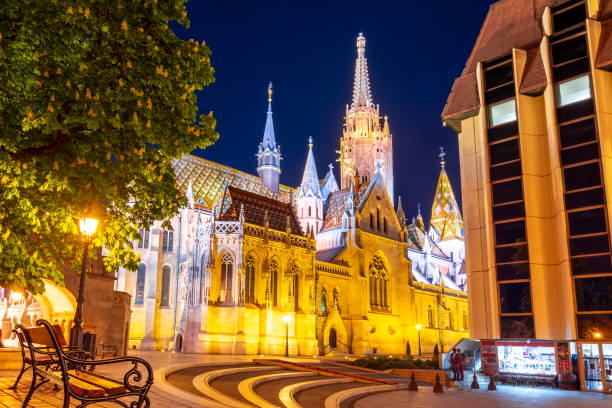
istockphoto -
Budapest's St. Stephen's Basilica is a Roman Catholic Basilica. It is named for Stephen, Hungary's first king, whose right hand is placed in the reliquary. Prior to 1920, it was Hungary's sixth biggest church edifice. It has been the co-cathedral of the Roman Catholic Archdiocese of Esztergom-Budapest since the renaming of the primatial see. It is currently the third largest church edifice in Hungary.
The Basilica is absolutely free to visit, making it one of the greatest things to do in Budapest on a budget. There is also a cupola at the top of the Church from which you can see the entire city for a nominal charge. In the 18th century, the location of the Basilica was a theater until residents petitioned to erect a church in honor of St. Stephen, Hungary's first monarch. It currently holds his mummified right hand, the Szent Jobb (Holy Right Hand).
The church's exterior includes neoclassical architecture, while the inside contains 50 different varieties of marbles sculpted by various sculptors. The interior decorating is stunning, with its assortment of marble columns and elaborate floor decorations. Natural light floods the domes of the Church, which have windows engraved with art and ceilings covered with golden leaves.
Location: Budapest-Lipótváros, Hungary

istockphoto 
istockphoto -
Szeged's Votive Church and Cathedral of Our Lady of Hungary has twin spires. It is located in Dóm plaza, next to the Dömötör tower. Construction began in 1913, but it was not finished until 1930 owing to the onset of World War I. The cathedral of the Roman Catholic Diocese of Szeged-Csanád is housed in the church. However, of all the things to do in Szeged, the most distinctive landmark and popular tourist attraction is the Votive Church. The Votive Church dominates the skyline with twin spires reaching 91 meters in height. The church, also known as the Szeged Cathedral, is the fourth biggest in Hungary and is decorated in Roman, Gothic, and eastern Byzantine styles.
The Votive Church, designed by Frederick Schulek, began construction in 1913 but was not finished until 1930 owing to the onset of World War I. The church is located in the spectacular Dom Square and houses five massive bells as well as one of Europe's largest organs. It is well known for its elaborate, colorful frescoes, the most notable of which is the "Madonna in Fur of Szeged", which depicts the Madonna dressed in traditional Hungarian peasant garb. Szeged may be reached by train from Budapest's Nyugati Station in about two and a half hours, or by car in about one and a half hours.
Location: Szeged, Hungary

istockphoto 
istockphoto -
Sopron is roughly 75 kilometers from the Austrian border and is a popular day excursion from Vienna. Budapest is around 200 kilometers away, to the east. In the town center, some of its walls and the Forum have been unearthed. However, it is only one section of the Old Town, which is also recognized for its many Baroque and medieval structures, as well as affluent mansions. The Firewatch Tower, or Tztorony, is easily the most spectacular of them and the city's prominent feature. As the name implies, watchmen ascended the stairs to the balcony (the Tower is 58 meters high) to examine the surrounding woodlands for fires as well as prospective invasions.
Because the Firewatch Tower is located in the middle of the Old Town, it has become a focal point for major cultural celebrations. The Tower watchmen were also singers who sang at town weddings from the Tower balcony. It is now the focal point of light displays during yearly festivals. The Tower, like everything else in Sopron, has Roman foundations and integrates numerous architectural styles. On top of the Tower, there is a baroque crest that was placed in 1676.
Location: Sopron, Hungary

istockphoto 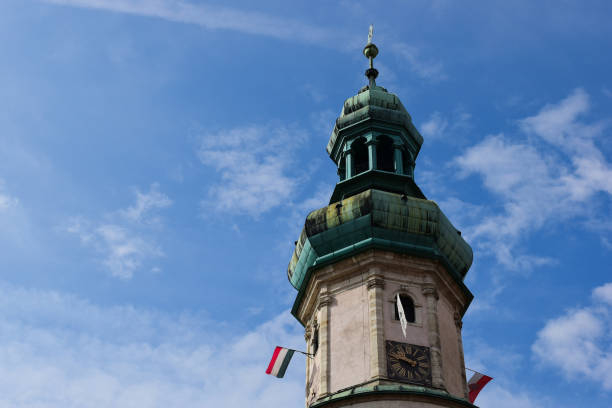
istockphoto






















